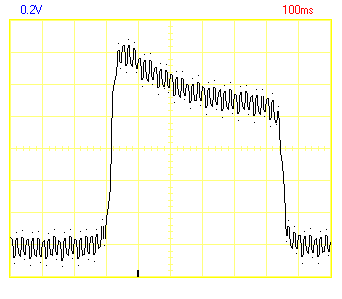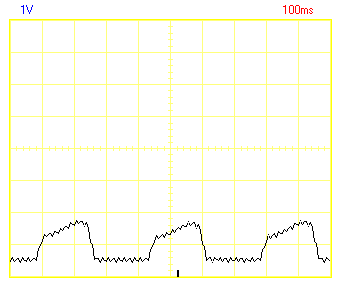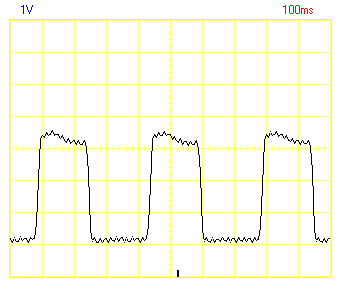(article continued from previous page)
Even the best algorithm can be foiled by poor input. A signal-to-noise ratio describes the level of good stuff (signal) compared to the level of bad stuff (noise). Many top engineers have made their careers out of developing methods to increase signal strength and decrease noise.
Electrical emissions from a computer monitor, fluorescent lamp, or electrical motor normally consist of much less electrical power than the output of a chip or transistor. So, the signal from a digital chip easily overrides the environmental electrical noise.
But, the photodiode (in this case a reversed LED) doesn’t put out much power. So much so, that stray electrical sources are comparable in voltage levels.

Oscilloscope trace of electrical noise amplified by the high-gain op amp. There is no signal in this image.
The above image illustrates ambient oscillating electrical noise leaking into the photodiode amplifier circuit when the photodiode is completely covered by an opaque material. Even though this is a battery operated circuit, the surrounding residential appliances, outlets, and cords are emitting electrical signals that are picked up by the circuit.
The original noise voltage level was quite insignificant, but now the noise has been amplified to about 0.2 V by the high-gain op-amp that is required to amplify the weak photodiode signal.

Oscilloscope trace of electrical noise overlaid on a rising and falling photodiode signal.
The photodiode is uncovered for the above image. In this case, the photodiode voltage is much greater than the background noise. The photodiode signal is clearly dominant. But, the background noise does roughen things up a bit.
Always be wary of any great amount of signal amplification, as the noise is amplified also. If you forget about this problem, you may be scratching your head when the robot goes crazy near the refrigerator or vacuum cleaner, which are both sources of significant electrical noise.
To reduce noise pick up, you can:
The last bullet point on the above list can be accomplished by adding a second photodiode -- which you see we did in the completed circuit. Depending on the application, this may not always be acceptable, as the second photodiode isn’t focusing on the same spot as the first. However, where appropriate, additional photodiodes can improve and smooth (average out) the signal.

Oscilloscope trace of the voltage level of a single unamplified photodiode.
The above image illustrates the response of a single photodiode before amplification. That’s about 1.25V.

Oscilloscope trace of the voltage level of a pair of unamplified photodiodes.
The above image illustrates the additive response of a pair of parallel photodiodes before amplification. More current flows because the surface area for photons has doubled.
In this example, I was surprised that the voltage more than doubled (it’s about 3.25V). It could be because:
Hopefully, the oscilloscope traces convince you of the value of using more than one reversed LED to increase signal strength. This becomes a required practice for higher energy wavelengths like green, blue, or UV.